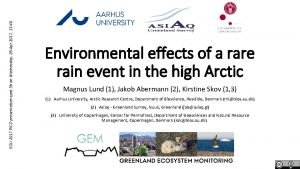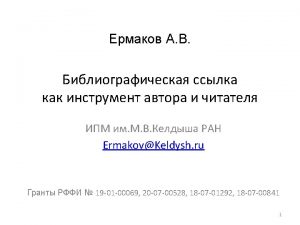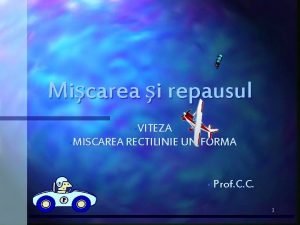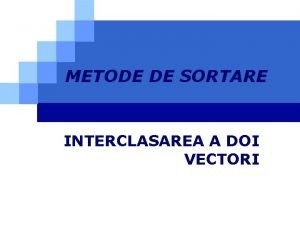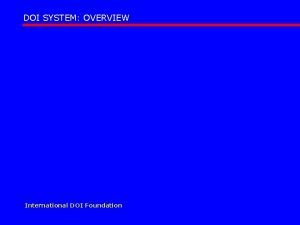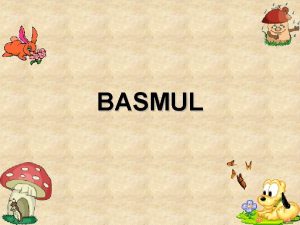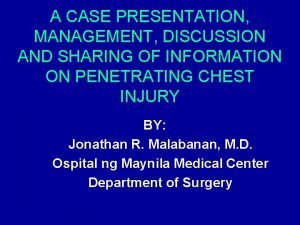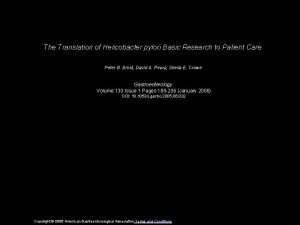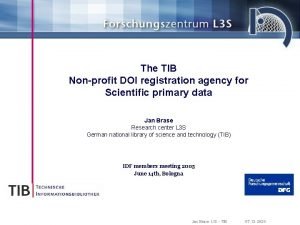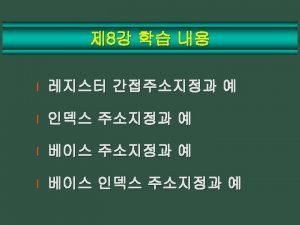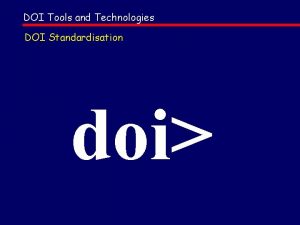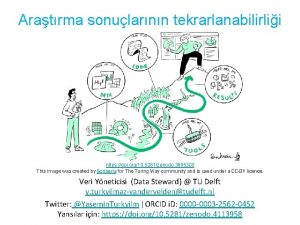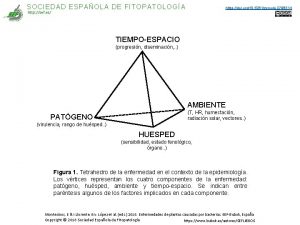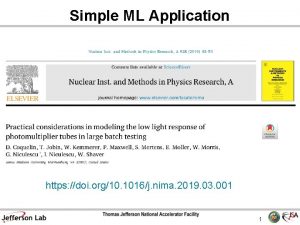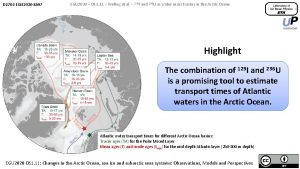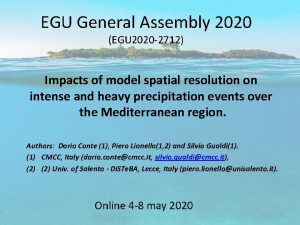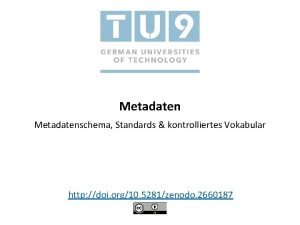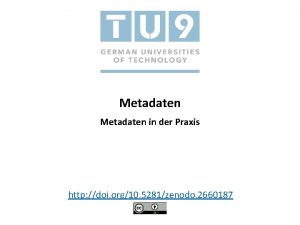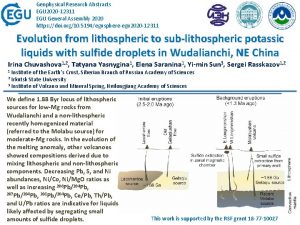EGU 2020 11688 https doi org10 5194egusphereegu 2020















- Slides: 15

EGU 2020 -11688 https: //doi. org/10. 5194/egusphere-egu 2020 -11688 Session HS-8. 1. 6 Abstract D 463

Specific takeaways • Data should be used for model testing rather than model development. • Using multiple lines of evidence (geophysical and remote sensing data) for model testing to gain more confidence in conceptualisations.

Current approach – using data for model development • The traditional approach is using data for model development. Here parameters of a single conceptual model are tuned to conform with the data through inversion. • Usually the model with the lowest mismatch between observed and modelled response is considered the best model.

Current approach – problems • Inversion is prone to spatial averaging, smoothing, biased parameter values due to inadequate conceptual model. • Many conceptual models represent data equally well but they are rejected by omission by only applying a single conceptual model. • No data left for testing the model The model is accepted because it fits the data used to develop it (circular reasoning).

Novel approach • An exploratory systematic testing framework based on Popper-Bayes philosophy is suggested. • The method aims at finding an ensemble of conceptual understandings that can be sufficiently explained by data.

Application study • We apply this approach to a simplified hydrogeological characterisation of the Wildman River Area (Northern Territory, Australia) and evaluate whether sinkhole-type depressions act as conduits for groundwater recharge. • The widespread, enclosed, sinkhole-like depressions have been mapped on satellite imagery.

1. Alternative model development • The conceptual model of the depressions consist of a physical structure and a process structure. • Alternative models for the two structure are developed based on a literature review. • The physical structure describes the different lithologies underlying the depressions. • The literature review was based on a general understanding of the geomorphological development of depressions. • The process structure describes water going into and out of the depressions. • The literature review was based on a basic understanding of groundwater-surface water interactions of the depressions.

2. Independent data identification • To test the physical structure seismic refraction data was collected at five depressions. • The travel-time of the compressional P-wave from a seismic source to a series of known receiver locations is measured and used directly as testing data. • For testing the process structures, Planet. Scope satellite imagery for 19 dates over the dry season was used. • The depressions all run dry during the dry season, albeit at different times; the observation of interest is the last day of water inundation.

3. Forward model run • The forward model for the physical structure is a shortest path raytracing model combined with a rock physics model. • A synthetic dataset of refraction seismic travel times is created • For the process structure the forward model is a bucket water balance model. • Generates a synthetic dataset of the duration of water inundation after the start of the dry season.

4. Model rejection • Models are rejected through comparison with data rather than intercomparison of model performance. • Physical structures are rejected through a novelty detection in reduced parameter space. • Process structures obtaining zero marginal likelihood are rejected. • When the observation (red cross) is plotting outside cloud of the synthetic realisations, the model is rejected. • Models with all realisations plotting outside the likelihood function (black line) are rejected.

5. Update probability • The probability of the model structures was updated and combined into conceptual models consisting of a physical structure (A-D) and a process structure (I-IV) for five depressions S 1 -S 5. • Of the 16 different conceptual models, only two would allow for the depression to act as conduits of recharge, A-II and B-II (dashed boxes). • Red crosses (x) represent rejected conceptual models. • In depression S 1 a high porosity zone is not likely and recharge limited if any. Posterior

5. Update probability • The probability of the model structures was updated and combined into conceptual models consisting of a physical structure (A-D) and a process structure (I-IV) for five depressions S 1 -S 5. • Of the 16 different conceptual models, only two would allow for the depression to act as conduits of recharge, A-II and B-II (dashed boxes). • Red crosses (x) represent rejected conceptual models. • In depression S 1 a high porosity zone is not likely and recharge limited if any. • Depression S 2, S 3 and S 4 are definitely a recharge features with a high porosity zone.

5. Update probability • The probability of the model structures was updated and combined into conceptual models consisting of a physical structure (A-D) and a process structure (I-IV) for five depressions S 1 -S 5. • Of the 16 different conceptual models, only two would allow for the depression to act as conduits of recharge, A-II and B-II (dashed boxes). • Red crosses (x) represent rejected conceptual models. • In depression S 1 a high porosity zone is not likely and recharge limited if any. • Depression S 2, S 3 and S 4 are definitely a recharge features with a high porosity zone. • Depression S 5 is least decisive in terms of the model structure for both the physical structure and the process structure, and more model testing is required to discriminate between model structures.

Conclusions • Rather than obtaining a single best fitting model, an ensemble of models all consistent with prior information is obtained. • Compared to the traditional inversion approach more information is provided on the conceptual model. • Although the framework is not directly prediction oriented, the testing of plausible conceptual models will ultimately lead to increased confidence of any groundwater model based on accepted posterior conceptualisations.

Thank you! FOR FURTHER INFORMATION Trine Enemark trine. enemark@csiro. au trine. enemark@flinders. edu. au Land & Water csiro. au/land-water REFERENCES Enemark, T. , Peeters, L. J. M. , Mallants, D. , Flinchum, B. A. & Batelaan, O. A systematic approach to hydrogeological conceptual model testing, combining remote sensing and geophysical data. Subm. to WRR.
 Esoc 2020 vienna
Esoc 2020 vienna Egu pico presentation
Egu pico presentation Crossref simple text query
Crossref simple text query Rumus wcto
Rumus wcto Sóc nhí câu đố
Sóc nhí câu đố Viver nao doi carlos drummond
Viver nao doi carlos drummond Miscarea uniforma
Miscarea uniforma Un om avea doi fii
Un om avea doi fii Interclasarea a doi vectori
Interclasarea a doi vectori International doi foundation
International doi foundation Doi feti cu stea in frunte rezumat
Doi feti cu stea in frunte rezumat Noi toi poi doi
Noi toi poi doi Doi
Doi Doi registration agency
Doi registration agency Ax=bx
Ax=bx Mình tròn thân trắng dáng hình thon thon
Mình tròn thân trắng dáng hình thon thon

